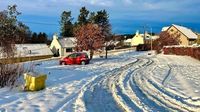Britain has just shivered through its coldest November night in fifteen years, as a bitter Arctic air mass swept across the country, plunging temperatures to record-breaking lows and causing widespread disruption. The early hours of Friday, November 21, 2025, saw thermometers in Tomintoul, Moray, Scotland, dip to a staggering -12.6°C (9°F), a temperature not seen in the UK since the -18°C recorded in Llysdinam, Wales, back in 2010, according to the BBC and Sky News.
It wasn’t just Scotland that felt the chill. The Met Office reported that England, Wales, and Northern Ireland all experienced their coldest autumn night of the year. In England, temperatures fell to -7.8°C (17°F), while Wales and Northern Ireland saw lows of -7.2°C (19°F) and -6°C (21°F) respectively. The coldest spot in Scotland was Loch Glascarnoch in the Highlands, which, alongside Tomintoul, became a focal point for the country’s deep freeze. Other cold pockets emerged in Trawsgoed, Ceredigion, and Rostherne, Cheshire, underlining the widespread nature of the cold snap.
This sudden plunge into winter was driven by a striking meteorological setup. As forecaster Simon Partridge explained to Sky News, “the cold weather was mainly caused by a small area of high pressure moving across the UK overnight.” The BBC added that this ridge of high pressure, anchored in the mid-Atlantic and stretching across Greenland, funneled a bitter Arctic air mass down over the British Isles, carried on strong northerly winds. Partridge noted, “the main difference between that and previous nights is the winds are a lot lighter,” which allowed the cold to settle even more deeply in the valleys and glens.
The impact on daily life was immediate and widespread. More than 100 schools were closed across north and north-east Scotland on Thursday, November 20, as heavy snow blanketed the region. Aberdeenshire alone saw over 30 schools shut, with one closure in the Highlands. Wales was also hit hard, with 36 schools closed in Pembrokeshire, 14 in Carmarthenshire, and seven in Ceredigion. North Yorkshire and East Yorkshire weren’t spared either, with 33 and eight schools closed, respectively, as reported by multiple outlets including the BBC and the Met Office.
Travel became treacherous, with roads up and down the country affected by ice and snow. In Aberdeenshire, part of the A90 was closed for several hours, and a double-decker bus became stuck in snow on the Banchory to Torphins road. The North York Moors saw cars stranded in heavy snow, while widespread frost made driving hazardous elsewhere. Authorities issued seven yellow weather warnings across the UK to alert people to icy conditions, urging drivers to exercise extreme caution. Pedestrians were advised to stick to pavements along main roads, and cyclists were told to favor main roads over side streets, which were likely to be more treacherous.
The Met Office’s yellow ice warnings covered a broad swath of the country on Friday morning, including Cornwall, eastern and south-east England, the East Midlands, Yorkshire & Humber, north-east Scotland, north-east England, and western Wales. These warnings were set to be lifted by Friday afternoon as the worst of the cold abated.
For those hoping to make the most of the wintry conditions, there was a silver lining. The Cairngorm Mountain snowsports centre near Aviemore in Scotland reported enough snow to offer skiing and snowboarding for the weekend of November 22-23, a rare treat for enthusiasts this early in the season.
But for many, the cold snap brought only inconvenience and hardship. Homes were left without power in some areas, and the sheer scale of school closures underscored the disruption to families and communities. The cold was so severe that even daytime temperatures remained well below the November average, and in some places, below the averages typically seen in the depths of winter. The BBC highlighted that Chivenor in Devon had recorded 14.8°C on November 5—its warmest Bonfire Night on record—illustrating the wild swings in weather the UK has experienced this autumn.
As the week drew to a close, meteorologists offered a glimmer of hope for those tired of shivering. Partridge reassured Sky News listeners: “Friday is really the end of the really cold weather as things turn back to average by the time we get into the weekend.” The BBC echoed this forecast, explaining that milder Atlantic air would soon replace the Arctic blast. Friday night was expected to start cold, with frost and temperatures as low as -5°C in rural southern England, but cloud and rain would move in from the west, raising temperatures and banishing the frost by Saturday morning.
The weekend forecast promised a transition. Saturday would bring rain to Wales, north and west England, and eventually central and eastern England, accompanied by gusts up to 40-50mph along Channel coasts. Scotland and Northern Ireland could look forward to brighter spells with a few showers. Highs were set to reach 8-12°C in the south and west, and 5-9°C in the north-east—still chilly, but a far cry from the week’s record lows.
Sunday was predicted to be wet and windy, with outbreaks of rain across most of the UK and gusts of 50-60mph along the western coasts of England and Wales—strong enough, the BBC noted, to bring down a few tree branches. Temperatures would remain a degree or two below average in the west and 3-4°C below average in the north-east, but the extreme cold would be over.
Looking ahead, forecasters anticipated an unsettled but milder week, as a series of Atlantic low-pressure systems would bring rain and winds across the UK. By Thursday, November 27, temperatures were expected to return to the seasonal average of 8-11°C, with highs widely reaching double figures.
This dramatic cold snap, though brief, served as a powerful reminder of the UK’s susceptibility to sudden and severe weather changes. From record lows and school closures to treacherous roads and rare early-season skiing, the nation experienced the full force of an Arctic blast—before, just as quickly, the weather began to turn once more.

